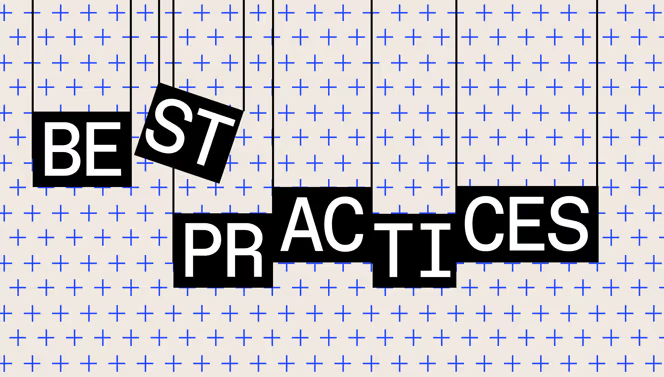8 Performance management tips for managers (and leadership best practices)

Discover Workleap Officevibe's benchmark report on 12 key employee engagement metrics

In business, there's doing what's required and then there's exceeding expectations. As a manager, you don't just want your employees to go through their days disengaged — you want them to excel, succeed, and thrive.
The performance management approach is a managerial style that prioritizes success, guiding your team to peak performance. In this article, we'll explore the tips and best practices every manager needs to master the art of performance management.
We'll learn how to boost employee performance, set goals collaboratively, offer helpful feedback, and create an atmosphere of growth and development. Let's go!
How performance management can boost employee performance
Performance management is more than just a workplace task — it's a catalyst for unlocking your team's true potential. Here's what performance management brings to the table:
- Motivation: Providing frequent feedback and recognizing accomplishments fuels employee motivation.
- Continuous improvement: It fosters a culture of growth and learning, where employees are encouraged to improve continuously.
- Goal alignment: Performance management ensures that individual goals align with the company's strategic objectives.
- Enhanced communication: Regular performance discussions promote open communication, allowing employees to voice their concerns and needs.
- Development opportunities: It identifies skill gaps and offers opportunities for training and career development.
- Transparency: Performance management processes are transparent, which builds trust between employees and management.
- Talent retention: Recognizing and rewarding performance helps retain valuable employees.
- Data-driven decision-making: Data collected during the process aids in informed decision-making.
When implemented effectively, performance management becomes a seriously great powerful tool that motivates employees to reach new heights, enhancing their contribution to the entire organization.
The benefits of making goal setting a team task
Goal setting is a huge part of performance management — it quite literally maps out the steps toward success. Want to know a secret? Engaging your team in setting goals together adds additional rocket fuel to your performance management process.
Here's how having goals benefits everyone (managers and employees) involved:
- Shared ownership: When employees actively participate in setting their goals, they have a sense of ownership and responsibility toward achieving them.
- Better engagement: Involving employees in setting goals sparks engagement as they contribute their thoughts and ideas.
- Improved alignment: Collaborative goal setting ensures that individual objectives align with team and company-wide goals.
- Genuine motivation: When goals are set collectively, there's a built-in support system. Team members motivate and help each other to achieve those goals.
- Clearer accountability: As everyone is part of the goal-creation process, accountability is collectively shared among the team members.
Incorporating performance management into your organizational culture and involving your team in setting goals are not just practices — they are dynamic strategies that can significantly boost employee performance and contribute to the overall performance of your organization!
Plus, effective goals end up playing a dual role — acting as key performance indicators (KPIs) that are an integral part of performance reviews.
Performance management techniques
Embarking on the journey of performance management requires a practical and people-centric approach. Read on for five tips that every manager should have in their toolbox to make the process effective, meaningful, and human-centered.
Tip #1: Get employee feedback on your performance review system
The foundation of an effective performance management system is communication. Active listening is key — start by hearing out your employees. Gain an understanding of their perspectives, needs, and the challenges they face.
A collaborative approach to designing your performance management process ensures that it resonates with the people who it's meant to support and guide. It's not just a one-way street — it's a dialogue that sets the tone for productive performance reviews.
Tip #2: Make time for every performance review and touchpoint
Carve out dedicated time for each performance review or informal touchpoint. This signals to your employees that you value their growth and development, and you're fully committed to this process.
An additional 15 minutes can make a heck of a difference to an employee struggling. It demonstrates your care and investment in their success. When employees see your commitment, they're more likely to engage meaningfully in the review.
Tip #3: Maintain a routine of feedback meetings and check-ins
Performance reviews shouldn't be annual rituals — they should be part of an ongoing dialogue. Regular feedback is a necessity. Fostering a culture of continuous improvement means that feedback becomes a routine part of how your team operates.
Frequent check-ins and feedback sessions keep everyone aligned, ensuring there are no surprises during the official performance review.
Tip #4: Lead by example to build a healthy company culture
A healthy company culture is the bedrock of an effective performance management system. To foster a culture that encourages growth, trust, and collaboration, lead by example. Demonstrate the behaviors and attitudes you want to see in your team. Build an environment where employees feel valued and respected.
Remember that a positive company culture isn't just a nice-to-have — it's a strategic advantage for your organization to have a workforce that's solid through and through.
Tip #5: Be open to feedback
Feedback is a two-way street. While you're assessing your employees' performance, they should also feel comfortable sharing feedback with you. Create an environment where feedback flows not only from you to your employees but also from your employees to you. Embrace constructive criticism as a means to improve your own performance as a manager.
By modeling openness to feedback, you encourage a culture of learning and growth within your team. It's a collaborative journey where everyone plays a part in enhancing performance.
Conducting performance reviews employees feel good about
Performance reviews shouldn't be an anxiety-inducing experience. They can be opportunities for constructive dialogue that leave employees feeling motivated, appreciated, and ready for growth.
Let's explore how to conduct performance reviews that genuinely uplift your team.
Tip #6: Prepare in advance
Lay the groundwork for a productive performance review
The key to a successful performance review is preparation. Before the review takes place, set the stage by gathering all relevant data, including an employee's past performance, goals, and areas for improvement.
By being well-prepared, you show your employees that you value the review process and their time. When you're equipped with the right information, the review becomes more focused, efficient, and meaningful.
{emphasize}💡 Consider gathering data on an employee's key performance metrics over the review period. Have they achieved their targets, met deadlines, or contributed to specific projects? This data forms the basis of a constructive review.{emphasize}
Tip #7: Keep things positive
Creating a constructive and supportive environment
A positive review doesn't mean skirting areas for improvement. Instead, it's about framing feedback in a way that motivates employees. Start the review by highlighting their achievements and successes, emphasizing what's gone well. Recognize their hard work and dedication. Then, transition into areas that need improvement.
By balancing positive feedback with constructive criticism, employees are more likely to accept areas for growth.
{emphasize}Instead of saying, "You need to improve your time management," try framing it as "You've shown excellent problem-solving skills. To further enhance your efficiency, we can work on some time management strategies together."{emphasize}
Tip #8: Make feedback constructive and actionable
The art of delivering feedback that drives improvement
Delivering constructive feedback is an art. It involves addressing areas for growth without discouraging your employees. It's about guiding them toward their best performance. Constructive feedback should be specific, focused on behavior, and offer actionable steps for improvement.
{emphasize}If an employee has struggled with meeting deadlines, don't just say "You're bad at deadlines." Instead, say "To meet your deadlines more effectively, we can implement time management techniques. Let's set up a plan to help you prioritize tasks and manage your time more efficiently."{emphasize}
By offering actionable feedback, you provide a roadmap for employees to enhance their performance, and they leave the review feeling empowered and confident about their ability to make meaningful changes.
The power of having a performance management process
A well-defined performance management process can be transformative. It's not just about performance reviews; it's a holistic strategy for enhancing performance and achieving your organization's goals. This process typically comprises several distinct stages that, when executed effectively, result in a more engaged and high-performing workforce.
Let's break down the six key aspects of a robust performance management process:
- Goal setting and expectations: The process begins with setting clear, achievable goals and expectations. It's crucial to align these individual objectives with the broader organizational goals. These objectives should be specific, measurable, attainable, relevant, and time-bound (SMART), creating a roadmap for employees to follow.
In a sales team, a goal-setting session might involve each salesperson defining their revenue targets for the year, specifying the industries or clients they will focus on, and setting milestones for quarterly assessments. - Ongoing feedback and coaching: Effective performance management involves consistent feedback and coaching. Regular check-ins provide employees with the opportunity to discuss their progress, seek guidance, and address challenges they may be facing.
A manager holds bi-weekly feedback sessions to discuss an employee's project performance. During these sessions, the manager provides feedback, highlights areas of improvement, and offers support to help the employee excel. - Performance appraisals: Performance appraisals, also called performance reviews or performance evaluations, are typically annual or semi-annual events. During this stage, the manager and employee meet to review the employee's achievements, strengths, and areas for development and set objectives for the future.
An annual performance appraisal could involve a comprehensive discussion of an employee's accomplishments over the past year. The manager might acknowledge the employee's successful projects and set new goals to align with organizational changes. - Employee development and growth: An essential aspect of performance management is supporting employees in their growth and development. This may involve identifying skill gaps and providing training or mentoring to bridge those gaps.
In an IT department, a performance management plan may include opportunities for employees to participate in relevant training courses, attain certifications, or work on innovative projects to enhance their skills. - Employee recognition and rewards: Recognizing and rewarding outstanding performance is a vital part of the process. Acknowledging employees' contributions and aligning these acknowledgments with documented recognition or tangible rewards fosters a culture of appreciation.
In a marketing team, several members may have created an innovative and eye-catching campaign. As a manager, you would encourage employees to share kudos through a peer-to-peer recognition engine. - Performance documentation: Accurate record-keeping is essential for documenting each step of the performance management process. Documentation ensures that the process is consistent, transparent, and legally compliant.
HR departments often maintain records of performance discussions, goal-setting documents, and the outcomes of performance evaluations in secure employee files, which can be reviewed as needed.
Each of these aspects plays a crucial role in engaging employees, aligning their efforts with organizational goals, and fostering continuous improvement.
When implemented effectively, this process transforms performance management from a routine task into a strategic approach for achieving long-term business success.
Performance management best practices for today's managers
Effective performance management is a dynamic process that adapts to the ever-changing work environment. To elevate your performance management, let's explore some of the best practices that can lead you and your team to success.
Connect employees to organizational goals and purpose
The first step in boosting employee performance is showing them how their daily work directly contributes to the broader business objectives and purpose. This connection helps employees see themselves as integral parts of the company's success.
Whether you're in sales, customer service, or software development, understanding your role in the grander scheme can be highly motivating.
{emphasize}A sales manager could illustrate how an individual salesperson's efforts directly impact company revenue, leading to expansion and exciting new projects. This connection between an employee's daily activities and the organization's growth can be a powerful motivator.{emphasize}
Provide support for underperformance
Recognize that every employee encounters challenging periods. Instead of resorting to punitive measures, provide the support and guidance necessary for them to get back on track. Offer assistance, additional training, or mentoring to help employees through their rough patches. By doing so, you're creating an environment where learning and growth are valued.
{emphasize}If an employee in your marketing team is struggling to meet campaign deadlines, offering a mentorship program or a time management workshop can be an excellent way to provide support and help them improve.{emphasize}
Promote employee growth and development
Foster a culture where your team takes ownership of their development. Provide opportunities and resources for them to grow and excel. Encourage continuous learning, whether it's through workshops, courses, or mentorship programs. By promoting employee growth and development, you not only enhance their performance but also invest in the future of your organization.
{emphasize}A software development manager could facilitate regular training sessions for their team, enabling them to keep up with the latest industry trends and improve their coding skills. This commitment to development can lead to a more competent, innovative, and efficient team.{emphasize}
Assess and adjust goals
Effective performance management involves regular evaluation of goals. Encourage employees to take ownership of their development. This sense of ownership drives a commitment to their objectives. If a goal is no longer relevant or needs adjustment due to unforeseen circumstances, be open to revising it.
{emphasize}Let's say your customer support team initially aimed to reduce response times by 20% within a quarter. However, due to increased customer inquiries, that target is no longer realistic. By assessing and adjusting goals as necessary, you ensure that employees work towards achievable objectives.{emphasize}
Unlock employee engagement through teamwork
Incorporate the power of frequent, collaborative goal setting into your performance management strategy. Engage employees in the goal-setting process, allowing them to contribute their insights and ideas. Collaborative goal setting not only results in more meaningful objectives but also boosts employee engagement.
{emphasize}Instead of a manager dictating new sales targets, they could gather the sales team for a brainstorming session. The team members, drawing on their front-line experiences, might suggest more achievable and relevant targets, ensuring everyone is invested in reaching these objectives.{emphasize}
The role of leadership in effective performance management
As a manager, you are the driver of your team's success. Leaders must possess an array of essential skills, including communication, empathy, delegation, giving feedback, coaching and mentoring, adaptability, and conflict resolution.
Leaders set the stage for open and honest communication. They listen actively, articulate employee expectations clearly, and provide constructive and timely feedback to ensure that employees understand their roles and the company's objectives. They provide consistent recognition to motivate and guide employees toward excellence. Skilled leaders also excel in resolving conflicts professionally, ensuring team cohesion.
Understanding your team's unique needs, concerns, and motivations is crucial. Leading with empathy creates environments where employees feel valued and supported, resulting in improved morale and performance. Leaders must be able to serve as coaches and mentors, offering ongoing support, addressing skill gaps, and providing development resources. Leadership isn't just about being in charge — it's about taking care of those in your charge.
But most importantly, good leadership is leading by example. Leaders who exemplify company values and work ethic inspire their teams to do the same.
Performance management software: The secret sauce for modern managers
Performance management isn't just a routine task — it's like a key that can unlock your team's true potential. By adopting these valuable insights and best practices, you'll see employee productivity climb and your organization speeding toward excellence.
Your organization is on the cusp of becoming a force to be reckoned with, and you're the one leading charge. So, seize the moment and lead your team towards greatness. Your journey is about to begin, and the possibilities are endless. There's excitement ahead!
Give HR and managers the clarity, confidence, and connection to lead better every day.


%20(1).avif)


.avif)
.avif)








